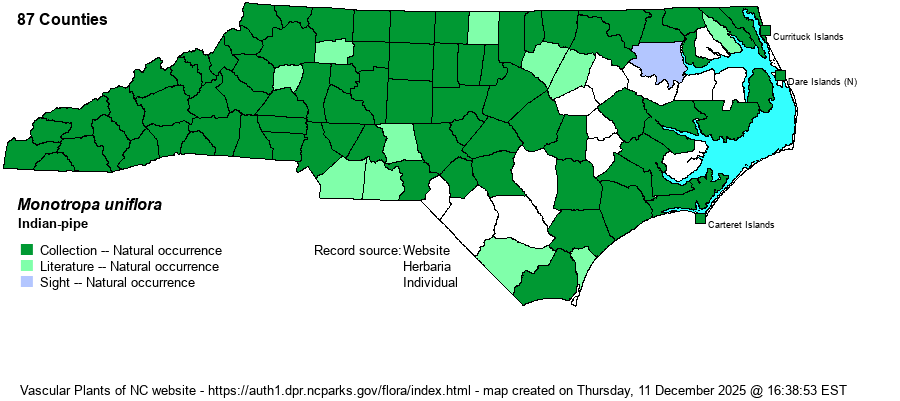| Author | L. | |
| Distribution | Essentially statewide, but of spotty occurrence in the Coastal Plain; however, seems likely to be present in all 100 counties. Note Taxonomic Comments below! A few of the records in the Coastal Plain might refer to the newly split-out M. brittonii (see that species account).
This is a very widespread species, being found over most of southern Canada, parts of the western U.S., and most of the eastern U.S. It ranges south to southern FL and eastern TX. | |
| Abundance | Infrequent to fairly common in the Mountains and Piedmont; uncommon to infrequent in the Coastal Plain, including Tidewater counties. Recorded on several barrier islands, as well. However, these more coastal populations might now relate to the very similar M. brittonii (which see). The NCNHP gave this species a revised State Rank now at the vague S2S4, likely meaning they aren't sure which Monotropa populations/records belong to which of the two species. However, the editors believe that nearly all refer to M. uniflora and continue to suggest a rank of S5, especially as Weakley (2024) shows it as "common" in all three provinces. And, NCNHP has placed this species on its Watch List, at least for now. | |
| Habitat | This species occurs in a wide variety of forests, but it favors upland ones under mixed hardwoods and pines. It can occur in somewhat more moist forests than the similar Hypopitys species, particularly so in the Coastal Plain. The similar M. brittonii is mostly restricted to sandy habitats such as Coastal Sandhill Scrub and Pine--Scrub Oak Sandhill natural communities. | |
| Phenology | Blooms from June to October; fruits one or two months after flowering. | |
| Identification | This is the very familiar "ghost pipe" of our forests, not seen every day but usually encountered a few to a good handful of times a year by biologists. It is a saprophytic herb without chlorophyll, with all parts of the plant being white or whitish, to occasionally light pink. It grows to about 5-6 inches tall, with the ovate leaves clasping the stem like scales. The single flower nods down from the top of the stem. It is larger than on the Hypopitys species, being close to about 2/3-1-inch long. The plant turns sooty to blackish upon drying. The species often grows in dense clusters, with at times a few dozen plants occupying less than a square-foot of ground. In addition, it must now be carefully separated from M. brittonii, which many authors now consider a valid species. See that species account for separation characters. | |
| Taxonomic Comments | Weakley (2020) splits out M. brittonii from uniflora. After this reference was put online, additional material on M. brittonii is now available -- a M.S. thesis by Keesling (2020), which is a detailed molecular analysis of both taxa.
| |
| Other Common Name(s) | Ghost-pipe, Ghost-plant, Indian-pipes (plural) | |
| State Rank | S2S4 [S5] | |
| Global Rank | G5 | |
| State Status | W7 | |
| US Status | | |
| USACE-agcp | FACU link |
| USACE-emp | FACU link |

